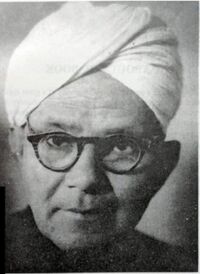Ram Dhan Singh

Rao Bahadur Dr. Ram Dhan Singh Hooda (May 1, 1891- April 17, 1977) was elder of the two sons of Ch. Shankar Singh, a peasant of village Kiloi in Rohtak district of erstwhile Punjab, now Haryana. He was the principal of the only college that existed in north India at Layallpur (now in Pakistan).
Doyen of crop science research



This illustrious son of India, born on May 1, 1891 became the doyen of crop science research. Under his dynamic leadership as Cerealist at Punjab Agricultural College and Research Institute, Lyallpur, nine improved varieties of wheat, eight of rice, five of barley and three of pulses were developed which changed the entire face of crop husbandry particularly of the north and central provinces of Indian sub-continent of pre-independence era.
Some of his varieties became popular in other countries as well and got international recognition. His modesty, simple and humble life style of honesty, hard work, devotion and dedication to duties offers great lessons as well as inspiration to agricultural scientists for generations to come. His outstanding contribution can't be confined to a particular state, region or a country.
Education
Ch. Ram Dhan Singh received his primary education in his native village Kiloi. He passed his middle school exam and matriculation examination from Govt. High School, Rohtak before joining D. A. V. College, Lahore in 1907 for doing his intermediate class. In1909 he joined Punjab Agricultural College, Lyallpur (now Faislabad in Pakistan) where athree year Diploma in Licentiate in Agriculture (L. Ag.) was started in the same year. He completed his Diploma in the first batch in 1912. He successfully did his Bachelor of Science degree in 1919 from Patna University while serving at Imperial Agricultural Research Institute, Pusa, Bihar. After this graduation he took private load for undertaking his higher studies at Cambridge (in England) which was the most famous agricultural research centre in commonwealth at that time. From Cambridge University he completed his M. A. degree in Natural Science (Tripos) and also Diploma in Agriculture.
Service
The Diploma holders of L. Ag. were promised to be placed in the grade of 100-10- 300 but they were actually offered a meagre starting salary of Rs.40/- per month in 1912. Many of his batch-mates joined service at this salary but Ch. Ram Dhan Singh joined service only in 1914 in higher grade at IARI, Pusa, Bihar and worked upto 1919 with Sir Albert Howard who was pioneer in promoting organic farming, selecting and breeding some new varieties of wheat. During this period he developed keen interest in plant breeding which became a passion for him to develop improved varieties of crops for improving the condition of poor peasantry.After returning from Cambridge University he joined Punjab Govt. service in 1925 as Fodder Specialist. But within a year in 1926 he shifted to the post of Cerealist - which he retained till his retirement. He became Principal of the Punjab Agril. College and Research Institute, Lyallpur in 1946, and retired from this coveted post in 1947.
Development of foodgrain varieties
Ch. Ram Dhan Singh was a practical plant breeder who spent most of his time in the field watching crop plants than sitting in the office chair. Coming from a farming family, Ch. Ram Dhan Singh very well knew the vicious circle of stagnant agriculture and chronic poverty among the peasantry. He wanted to break this vicious circle in his own way through the development of disease resistant, high yielding crop varieties of better grain quality. He was successful in this endeavour to a great extent.
Wheat varieties :
Wheat was the key crop of erstwhile Punjab and Ch. Ram Dhan Singh changed the entire face of wheat husbandry not only in the then Punjab but far and wide with his development of wheat varieties Pb-518 & Pb-591 in 1933-34. Wheat Pb-518 was relatively a short statured variety having stiff straw and resistance to lodging while Pb-591 was a disease resistant, good yielder and bold shining grains with excellent chapati making characteristics. Therefore, Pb-591 with its pearly and rounded appearance and better quality always fetched a premium price over other wheats. These varieties were widely cultivated not only in pre-independence Punjab but rapidly spread to North-Westem Frontier Province, Sind, the then United Province, Rajasthan & Gujrat but also crossed national frontiers as far as Canada, Brazil, Mexico, Soviet Union and other countries.
Ch. Ram Dhan Singh initiated cross breeding of improved wheats to create more variability and develop new varieties. Eventually he developed other famous wheat varieties C-217, C-228, C-250, C-253, C-273, C-281, C-285, etc. Some of which were released after his retirement. He was pioneer in taking nursery of rabi crops in Lahaul Valley (now in Himachal Pradesh) to cut short the period of developing new varieties. He was also pioneer in establishing a modem milling and baking laboratory for the first time in India which was probably the first of its kind in whole of Asia for testing the milling and baking quality of wheat varieties. He also developed a rotary screen for the complete elimination of weed seeds from wheat seeds in 1934 which became popular with the farms of Department of Agril. and among progressive farmers to control weeds.
Dr. Norman E Borlaug - the famous wheat breeder and Director CIMMYT visited IARI, New Delhi in 1963 and made a special call on Rao Bahadur Ch. Ram Dhan Singh at his Sonepat residence and emotionally touched his feet to pay his respects to the doyen of wheat research of India. Dr. Borlaug had achieved the break through he was looking for when he crossed the stocky Japanese wheat variety Norin-10 with rust resistant Mexican wheat in 1961-62 and developed high yielding wheat varieties like Sonora-63, Sonora-64, Lermo-Rojo 64 etc – which were tested in India in field trials in 1962-63 crop season at IARI New Delhi, Ludhiana, Pantnagar and Kanpur. These performed very well under good fertilizers and irrigation. In response to Dr. Borlaug's question whether he could observe dwarf wheat plants in his material, Ch. Ram Dhan Singh replied that he had dwarf lines in his material. He could also develop dwarf wheat varieties but perhaps dwarf varieties would not have been so popular in the absence of chemical fertilizers and lack of assured irrigation facilities of his time. Subsequently on becoming a Nobel Laureate Dr. Borlaug sent Ram Dhan Singh a special coin struck to commemorate the continuation of Mexican wheat to the world fight against hunger in appreciation of the role played by Ram Dhan Singh in improving wheat plants to banish hunger.
Rice varieties :
Ch. Ram Dhan singh is mainly known for his outstanding wheat research but he was a great Cerealist rather than a mere wheat breeder. He developed equally outstanding improved varieties of rice which is the main cereal of our country. In view of very scanty rainfall, Punjab province was not a traditionally rice growing area, yet, rice was grown under irrigated conditions both in plain and hilly regions of the state. Of the eight new varieties developed by him five namely Basmati-370, Jhona-349, Mushkans-7 & 41 and Palman suffaid 246, were for plains and the other three viz. Ram jawain 100, Phul patas-72 and Lal Nankand 41 were for hilly areas. Purple leaved rices commonly grown in Kangra district to fight the wild rice problem were the results of the cross-breeding efforts. Out of his rice varieties Basmati-370 deserves special mention on account of its superfine quality and fragrance – which is very popular and is in demand in western countries. By developing Basmati variety during his time Ch. Ram Dhan Singh has made earstwhile Punjab of India and Pakistan the owner of Basmati germplasm.
Barley varieties:
The best lands with good irrigation facilities were alloted to wheat in Rabi season; barley comes only next in preference both with regard to choice of land as well as irrigation. Nevertheless barley is a hardy cereal which can give reasonable yields even under low fertility conditions. Being more tolerant to salts, barley is preferred on saline and alkaline conditions of land. Ch. Ram Dhan Singh developed improved varieties of barley like T4, T5, C138, C141, and C155, which suited to rainfed or limited irrigation conditions and salt affected areas. These varieties helped lower income group peasantry because barley is consumed primarily as a food by lower income group consumers. Barley has the cooling property and thus is suited for its consumption during north Indian summers. Rao Bahadur Ch. Ram Dhan Singh submitted a scheme in 1933 for processing of barley into malt. Thus Ch. Ram Dhan Singh tried to develop those varieties of cereals which could suit to the requirements of agro-industries for processing so as to generate more employment and income opportunities for the peasantry.
Pulse varieties:
Ch. Ram Dhan Singh's researches were not confined to cereals only, but also extended to pulses which were generally in short supply in those days. He developed two Moong varieties namely Moong No.54 and 305 and also a mash variety No.48. Thus Ch. Ram Dhan Singh made outstanding contributions in the improvements of wheat, barley, rice and pulses by developing a number of improved varieties of these crops. Perhaps no other breeder in the world has so many varieties to his credit as Ch. Ram Dhan Singh has. His work proved that the quality of leadership in agricultural research was as important as in other fields of human endeavour and all notable advances were initiated by individuals and not by the systems of organisation.
Retired life
Ch. Ram Dhan Singh remained active in educational and philanthropic activities after his retirement from service in 1947. He remained president of the governing bodies of number of jat educational institutions at Rohtak for eight years and strengthened them financially and by framing appropriated rules and regulations for their systematic and efficient functioning. He was a fellow of Punjab Agricultural University, Ludhiana for four years during sixties. He earned a special appreciation of the Vice-Chancellor by making very valuable contributions as a member of the Regulations Committee to the framing of rules and regulations of the Punjab Agricultural University. Ch. Ram Dhan Singh had been a member of a good number of agricultural research and development committees. He had been a member of the Board of Management of Haryana Agricultural University, Hisar from February 1971 to May 1974. He used to visit the university farm and interacted with the breeders to make crosses and selection of the desired material. He always encouraged the young scientists who worked very hard and developed a number of high yielding varieties which further boosted the crop yields. Especially the wheat breeders had developed and released two very high yielding varieties C306 for limited irrigation in 1965 and WH147 for medium fertilizer and irrigation condition in 1975 - involving the material developed by Dr Ram Dhan Singh. These two varieties were grown in large areas of the country across various states and brought green revolution in wheat production. These varieties are still popular in Haryana, Punjab, Rajasthan, Madhya Pradesh, Chattisgarh and some parts of Uttar Pradesh. The variety WH147 once was grown in Pakistan in an area of 5 lakh hectares which strengthened food production in Pakistan as well. C306 is the only desi variety known for its shining bold grains and good chapatti making quality which fetches a high rate in the market.
Ch. Ram Dhan Singh has contributed numerous articles of scientific and popular interest on agricultural subjects to the press media both in English and vernacular languages. He was a great linguist. During his old age he had compiled with hard labour a volumenous dictionary of roots and words common to English and oriental languages of India, particularly Sanskrit for its publication. Only a few days before his death he had written a letter to a Bombay Publisher for the publication of his dictionary. The publisher sent the acknowledgement in the positive but there was nobody to send the manuscript for publication after his death as Ch. Ram Dhan Singh was living alone at his residence in old age. Receiving no response for quite sometime the publisher himself came from Bombay to collect the manuscript of the dictionary. By that time somebody had disposed of all his books and manuscripts of the dictionary as a waste. Not even a single copy of the manuscript was traceable. The Publisher went empty handed.
Death
Rao Bahadur Ch. Ram Dhan Singh, a great son of India, left for his heavenly abode on April 17, 1977. For his hard, dedicated and selfless service to agricultural sciences and farmers of India, he deserves all appreciation and honor from the people of the country. The Govt of India ought to confer upon him the highest civilian award ‘The Bharat Ratna’.
Honours and Distinctions
In view of his outstanding achievements in plant breeding research in general and wheat research in particular, Ch. Ram Dhan Singh was honored by way of a number of recognitions. These included the much coveted Sir Maynard Ganga Ram prize of Rs. 3000 for his outstanding work on development of superior wheat varieties. In those days Rs. 3000 was an hefty amount. This award was to be given every three years for the inventor of any practical method of increasing the profits of agriculture in the Punjab. The title of Rao Bahadur was conferred on him in recognition of his extra-ordinary research work. He commanded great respect from all quarters in India and abroad. He was invited to participate in the golden jubilee function of Lyallpur Agriculture College in 1961. The President of Pakistan Muhammad Ayub Khan received and embraced Ch. Ram Dhan Singh in his arms at the international border. During the function at Lyallpur, the president himself presented a gold medal to Ch. Ram Dhan Singh appreciating his contribution and even offered him to stay in Pakistan, with all due honors, and to help in furthering the agriculture development.
Shri C. Subramanium, one time Union Minister of Agriculture in his address to All India Wheat Research Workers Seminar on wheat at the Punjab Agricultural University, Ludhiana on August 5, 1965 said that Pb591, evolved in the thirties still occupies the largest area under any single variety. Dr. Norman E. Borlaug on becoming a Nobel Laureate, wrote from Mexico in November 1970 to Ch. Ram Dhan Singh "l share with you the long experience of struggling to improve wheat plants. I recall vividly the first time I had the honour of meeting you during my visit to IARI, in 1963. Prior to that I had known you only through the excellent wheat varieties which you had produced, originally for the Punjab but which subsequently were grown extensively throughout the Indian Sub-continent as well as in many other countries."
The Old Boys Association of the Punjab Agricultural University, Ludhiana, awarded him Role of Honour in 1964. In recognition of his services as the most illustrious wheat breeder of India. The Punjab Agricultural University conferred on him the degree of Doctor of Science (Honoris causa) in a special convocation held on 23.2.1970 and honoured him by naming its Plant Breeding Laboratory at Ludhiana Campus after him. At the time of conferment of the Honoris causa degree of D. Sc. on him by the P. A. U. Chancellor, its then Vice-Chancellor, Dr. M. S. Randhawa said that Ch. Ram Dhan Singh is literally a national hero who has contributed a great deal to achieve self sufficiency in food and that by honouring him the Punjab Agricultural University is acknowledging the debt of gratitude the people of India owe to him.
Haryana Agricultural University, Hisar, honoured Ch. Ram Dhan Singh by naming after him a residential complex as Ram Dhan Singh House at Hisar Campus. Haryana Agricultural University also bestowed another distinction upon him in the form of Honoris causa degree of D. Sc. on April 7, 1973. Presenting Ch. Ram Dhan Singh to the Chancellor of the University the founder Vice-Chancellor of HAU, Shri A. L. Fletcher described him not only a great agricultural scientist but also a great teacher with an abiding interest in the welfare of education of youth and he added that the life of the 82 year old patriarch has been a saga of dedication and devotion to the cause of agricultural sciences and research. He further added that Dr. Ram Dhan Singh revolutionalised wheat husbandry in the country by evolving wheat varieties Pb518, Pb591 and other varieties. He has done outstanding work in rice, barley and pulses. The University is also awarding annually Rao Bahadur Ram Dhan Singh Gold Medal to the most meritorious student of Master of Science in Plant Breeding in the annual convocation function.
A seed production farm of 4000 Acres has been named as Dr. Ram Dhan Singh Seed Farm, CCSHAU Hisar which meets the seed requirement of the farmers of various crop varieties to a great extent.
A farmers’ field day was held at the ancestral village of Dr. Ram Dhan Singh, Kiloi (Rohtak) on March 6, 2000 by the Dept of Plant Breeding, CCSHAU Hisar. Demonstration of all improved wheat varieties had been laid out at farmer’s field. A large number of farmers of Kiloi and neighbouring villages attended this function held at Dr Ram Dhan Singh Sport Stadium. The university scientists apprised the farmers of the crop varieties and the latest technologies for crop production. A very enthusiastic response was provided by the participating farmers, along with a request that such events be organized from time to time, and a statue of Dr. Ram Dhan Singh be installed in the stadium. At this occasion, Dr. R.K.Rana, Senior Wheat Breeder assured the farmers that such field days will be held from time to time while suggesting that the Govt. be approached for the installation of a statute. The villages approached the Hon’ble Chief Minister of Haryana Ch. Bhupinder Singh Hooda who sanctioned the budget and unveiled the statue of Dr. Ram Dhan Singh – on January 30th, 2007 in the stadium. At this occasion Dr.R.K.Rana, then the Head, Dept. of Plant Breeding addressed the large gathering and lauded the role of Dr. Ram Dhan Singh in improving the agriculture of India which boosted the food production and brought prosperity to the lives of the farming community – an aim, for which Rao Bahadur Ch. Ram Dhan Singh strived throughout his life.
हिन्दी में एक संक्षिप्त लेख

(Source unknown. Text copied from a message circulated at WhatsApp Mobile App)
किसान-पुत्र महान् कृषि वैज्ञानिक डा. रामधन सिंह जी ने गुणवत्ता में सर्वोत्तम गेंहू C306, बासमती-370 ईजाद करके 1925-45 में दुनिया को हरितक्रांति की राह दिखाई!
जिस महान् मानव के कारण दुनिया के 100 करोड़ लोग भूखे मरने से बचे (1960 के दशक में) उनको जानें........!!!
जी ,मैं बात कर रहा हूँ "हरित क्रांति" के अग्रदूत विश्व-विख्यात कृषि वैज्ञानिक डॉ. रामधन सिंह हुड्डा जी की।
1 मई 1891 में रोहतक जिले के किलोई गांव में साधारण किसान के घर इस असाधारण बालक ने जन्म लिया। हमारी ज़ाट बिरादरी से शायद पहले होंगे जो लंदन कैम्ब्रिज में पढ़ने गए। प्राकृतिक विज्ञान और कृषि में Ph.D करने के बाद 1925 में Punjab Agriculture College and Research Institute ,Layallpur(Punjab) में प्रिंसिपल लगे। 1947 में रिटायरमेंट तक वहीं रहकर भारत ही नहीं, दुनिया के लिए नई नई किस्में इज़ाद की गेहूं, जौ, धान, दाल, गन्ना की।
Canada और Mexico ने सबसे पहले इनकी गेहूं C-591 अपनाई और पैदावार के रिकॉर्ड बनाये।
C-217,C-228, 250, 253, 273, 281 और C-285, C-518 उनकी मुख्य गेहूं varieties हैं।
जिस C-306 गेहूं को सबसे स्वादिष्ट माना जाता है उसे डॉ. रामधन सिंह जी ने ईज़ाद किया था। संसार में मशहूर बासमती चावल 370 और Jhona 349 भी डॉ. रामधन जी की ही देन हैं।
उनके योगदान का अंदाजा यों लगा सकते हो, जिसको Mexico से नोबल पुरस्कार विजेता डॉ. Norman E Borlog 1963 में डॉक्टर रामधन सिंह जी से Sonipat उनके घर पर मिलने आए और रामधन सिंह जी के पैर छू कर कहें - आपने संसार को बेहतर किस्में देकर 100 करोड़ लोगों को भूखे मरने से बचा लिया - और खुशी से रो दिए।
1965 में लाल बहादुर शास्त्री जी ने डॉ. रामधन सिंह जी को किसी भी राज्य के Governor बनने के लिए कहा था लेकिन डॉक्टर रामधन सिंह जी ने कहा राज्यपाल बनने से ज्यादा भला मैं वैज्ञानिक के तौर पर कर सकता हूँ देश का। और उन्होंने ऐसा किया भी।
1961 में पाकिस्तान ने डॉ रामधन सिंह जी को राष्ट्रपति गोल्ड मैडल से सम्मानित किया और वह यह सम्मान पाने वाले पहले भारतीय बने।
20 अप्रैल 1977 को डॉ रामधन सिंह जी इस संसार को अलविदा कह गए लेकिन सबको जिंदा रहने के लिए अथाह अनाज भंडार दे गए।
- हम क्यों नही जन्मदिन मनाते उनका?
- खाते हैं 306, 370 और चूसते हैं गन्ना 312 जिनका?
- सबको बताएं महान् किसान पुत्र की महान् देन दुनिया को।
डॉ रामधन सिंह जी अमर हैं।
References
Back to The Technocrats

